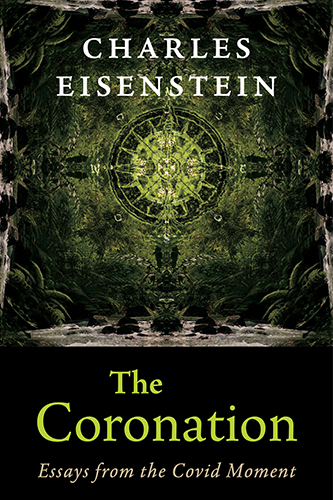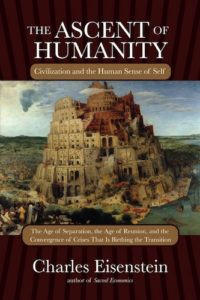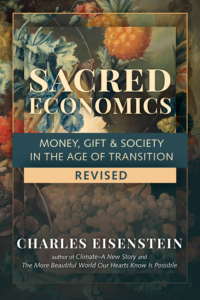The More Beautiful World Our Hearts Know Is Possible
Chapters
Chapter 30: Story
One day Confucius was walking along with some disciples when they came upon two boys arguing. Confucius asked the boys what the dispute was about. They told him they were arguing about whether the sun was nearer at dawn and farther away at noon, or farther away at dawn and nearer at noon. One of the boys argued that the sun appeared larger at dawn and smaller at noon, so it must be closer at dawn and farther away at noon. The other boy argued that it was cool at dawn and hot at noon, so the sun must be farther away at dawn and closer at noon. Confucius was at a loss to determine which one was correct. The boys jeered at him, “Who said you were so smart?”
This story is from the ancient collection of Taoist allegories known as the Liezi, as rendered by Thomas Cleary in Vitality, Energy, Spirit: A Taoist Sourcebook. Cleary explains, “[The story] illustrates the limitations of discursive reasoning, thus hinting indirectly at a more comprehensive mode of consciousness. Presented as a joke at the expense of Confucius, it illustrates how logic can be coherent within the bounds of its own postulates yet be ineffective or inaccurate in a larger context.”
We have seen already how so much of what we consider to be real, true, and possible is a consequence of the story that embeds us. We have seen how the logic of Separation leads ineluctably to despair. We have seen how evil is a consequence of the perception of separation. We have seen how the entire edifice of civilization is built upon a myth. We have seen how civilization has been trapped, indeed, in its “own postulates,” its ideology of intensifying control to remedy the failure of control. We have seen how so many of our efforts to change the world embody the habits of separation, leaving us helpless to avoid replicating the same in endless elaboration.
As Cleary suggests, to exit this trap we must operate from a larger context, a more comprehensive mode of consciousness. This means not only inhabiting a new story, but also working in the consciousness of story. If, after all, our civilization is built on a myth, to change our civilization we must change the myth.
By now it should be clear that this is no recipe for inaction or for mere words. Any action that is open to symbolic interpretation can be part of the telling of a story. And that is every action. We humans are meaning-making animals, constantly seeking to make sense of the world. When Pancho Ramos Stierle spoke to the abusive policeman with kind respect, he opened a rupture in that man’s story of the world.
Paradoxically, actions that are designed to be symbolic are usually less powerful story-disrupters than actions that are taken in earnest. I have been reading about the Shuar tribe in Ecuador, who have vowed to forcefully resist the destruction of their rainforest by mining companies looking for copper and gold. Said one Shuar chief, Domingo Ankuash, “The forest has always given us everything we need, and we are planning to defend it, as our ancestors would, with the strength of the spear. To get the gold, they will have to kill every one of us first.”
Let’s consider the potency of these words. They were not a calculated PR device. Already the Shuar have evicted mining outfits from several preliminary locations. This fierce tribe is obviously willing to die to protect their land. Their words are true through and through.
On the other hand, if they are successful it won’t be because their spears have overcome the tanks, machine guns, helicopters, defoliants, and bulldozers that the government might deploy to protect the mining companies. They cannot possibly overcome industrial civilization by force. Industrial civilization, after all, is the master of force, harnessing every possible source of stored energy to exert force upon the material world. Force is the essence of our civilization and our technology. The Shuar will not beat industrial civilization at its own game. Yet the Shuar are going to win. Let us understand why. What game are they playing? If we, aspiring changemakers, can understand that, then perhaps we can win too.
Whatever game they are playing, we might recognize it as the same game Diane Wilson was playing in the story I related earlier, the same game Pancho was playing, perhaps the same game the indigenous women in western Canada are playing in the Idle No More movement to stop the ravaging of their lands. In a sense, all of these people are being naive. Such movements do not always prevail—or do they, in some way we cannot see? What of all the exterminated tribes who died protecting ecosystems that are no more? Were their efforts in vain? Will your efforts be in vain, to create a more beautiful world?
The first thing I notice about the Shuar is that their commitment is to the land, the forest, the tribe, and to what they hold sacred. It is not a fear-based response to a threat; indeed, they are facing much greater personal risk by resisting the Onward March of Progress than they would be acquiescing to it.
The second thing I notice is that they are not fighting against something; they are fighting for something. They have a vision of their land as it should be. They have something bigger than themselves they can commit to. I suspect that as they deepen their involvement in resistance, their vision of what they serve will grow. In contrast, many activists today are consumed with stopping this and stopping that; rarely do they frame their vision in terms of what they want to create or what larger thing they serve. One symptom of this deficiency is the goal of “sustainability.” What, exactly, do we want to sustain? Is the purpose of life merely to survive? Are the creative powers unique to humanity without a purpose in the unfolding order of nature? We need to be able to see a vision of what’s possible that we can commit to.
A third thing is that even though the Shuar didn’t conceive their resistance actions with symbolic intent, they are nonetheless potent carriers of meaning. They make the story that it is perfectly fine to take minerals from the Amazon a lot harder to maintain. The mining companies do their best to construct that story—the trees will be replanted, the waste tailings kept in safe containment pools, and besides, the Shuar are killing wildlife with their hunting and their children aren’t attending school—but to add to these absurdities another, that the Shuar are benighted savages who don’t know what’s good for them, is perhaps too much for that story to bear, when the Shuar believe so fervently that they are willing to lay down their very lives.
If the Shuar succeed in preserving their homeland, it won’t be because their spears overcame civilization’s machine guns. It will be because the story that justifies killing them and taking the minerals wasn’t strong enough to withstand their challenge. It will be because enough people in key positions declined to take up the guns, bombs, and bulldozers. It will be because we—the industrialized world—refrained from using the force at our disposal. A strong story would be able to justify and rationalize everything necessary to get that gold. Half a century ago, few people would hesitate to agree that it is unfortunately necessary to clear the Indians away from the path of progress. Until recently, we had no compunctions in killing “every last one of them.” But today our story is infirm.
When a story is young and hale, it has a kind of immune system that insulates its holders from cognitive dissonance. New data points that don’t fit the story are easily discarded. They seem outlandish. The immune system responds in a variety of ways. It can attack the bearer of the disruptive information: “What are that guy’s credentials?” It can muster a few superficially convincing rebuttals and pretend that the offender has not thought of those and has no response: “But technology has vastly increased the human life span, so we need to get the minerals from somewhere.” It can appeal to the implicitly assumed rightness of the system: “Surely, scientists and engineers have determined that this is the least ecologically disruptive way to do it.” Or it can discard the offending information into the bin marked “anomaly,” or simply toss it down the memory hole.
When a story grows old, none of these immune responses work as well. Inconsistent data, even when dismissed, leaves a lingering doubt. Like an aging body or a womb nearing childbirth, the story becomes less and less comfortable. This is why people like the Shuar might succeed where others like them have, for thousands of years now, failed. Their resistance might dislodge us from the story that enables the pillage.
The Shuar are not a peaceful people, and they have evicted prospecting crews and machinery under threat of force. They are not, however, at war, in the sense that they are not striving to defeat an enemy. In contrast, much of our popular culture and the mentality of war see victory in terms of overcoming, by force, the perpetrator of evil. So for example, in the movie Avatar, which closely parallels the situation of the Shuar, the fictional Na’vi overcome the spaceships and artillery of the human invaders with spears, bows and arrows, and large animals. When the chief human general is killed, then the victory is complete. There is no other way, since he is depicted as irredeemable. Fortunately, the Shuar seem not to be infected with the virus of the ideology of “evil.” They are not fighting the mining companies. They are fighting the mining.
I would have liked to see a different ending to Avatar. I would have liked to see the planet infiltrate the nervous systems of the humans so that, when they destroyed its world-tree, they themselves felt the pain of it, erasing the us/them divide that enabled them to see the planet as a mere source of resources. That is precisely the change of perception that our civilization needs to undergo. Because I don’t think that the Shuar are going to overcome us with their spears.
They might, however, with their spears, their words, and other actions, overcome our stories. In this, all of us might join them and learn from them. What is the difference between the kind of symbolically potent force the Shuar are using, and run-of-the-mill violence and terrorism? It is, after all, a small step from the necessarily asymmetrical struggle the Shuar are engaged in to what people today call terrorism. I would not be surprised if the Ecuadorian government levels that epithet against the Shuar soon.
I will not here attempt to penetrate the thicket of distinctions between terrorism and asymmetrical warfare, and the possible justifications for each. I will just say that as we migrate from the concrete (stopping this bulldozer from felling these trees right here) to the abstract (striking a blow at an enemy or a symbolic blow for a cause) we enter dangerous territory.
To paraphrase Martin Luther King Jr., you can kill the haters, but you cannot kill the hate; in fact, you will create even more hate by even trying. Moreover, in the present world you are bound to fail, because those in power can easily outkill you.
To see how deeply ingrained the habit of separation called “conquering evil” is, look at how consistently we frame any attempt to enact social or political change as a “fight,” a “struggle” or a “campaign.” All military metaphors. We speak of “mobilizing our allies” to exert political “pressure” in order to “force” our opponents to “surrender.”
Again, I am not saying there is never a time to fight, nor do I intend to settle here the long and nuanced debate over nonviolence. Broadly enough interpreted, violence—that which “violates” another person’s boundaries—is unavoidable. A public protest that causes traffic jams feels violating to the poor sap commuting an hour each way to work from the low-income exurbs. In transitioning to a new world, the disruption of the old is inevitable. But when the violence comes from the hatred or demonization of the other, it is founded on an untruth. Let us not deceive ourselves into using the familiar, comfortable tactics and metaphors of force, when more potent processes for change may be available to us.
The reason that the defiance of the Shuar moves us isn’t that they are willing to kill for their cause; it is that they are willing to die for it. This is, in pure form, service to something greater than oneself. This is what we must emulate if we are to cocreate the more beautiful world our hearts know is possible. It is also a way to transcend the separate self, since to bow into service is to merge with something greater, something whose power to precipitate change extends beyond our understanding of causality. Then, the unexpected, the improbable, the miraculous can happen.
The more firmly we stand in a larger Story of Self, a Story of Interbeing, the more powerful we become in disrupting the old Story of Separation. I think questions of violence and nonviolence, ethics and principles, right and wrong, lead us into a conceptual maze. See, the sun is nearer at noon. No, it is at dawn. Every evil deed and every cowardly inaction that has ever been perpetrated on this earth has been justified by principle—the logic of a story. As we sober up from our long intoxication with the Story of Separation, we have the chance to enter a “more comprehensive mode of consciousness”—the consciousness of story. In it, we ask ourselves, “What story shall I stand in?”






